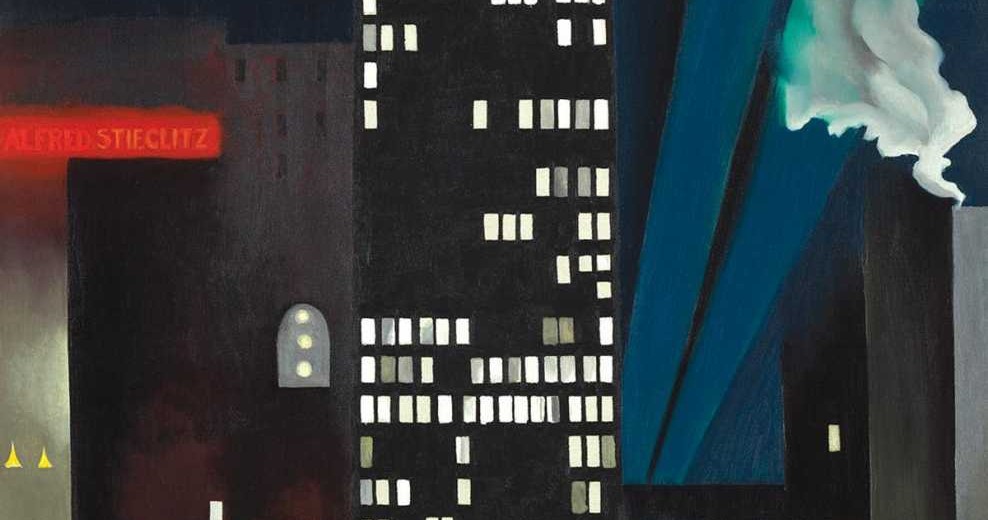

Radiator Building, Night, New York (1927) by Georgia O’Keeffe
Georgia O’Keeffe and Alfred Stieglitz had an extraordinary personal and artistic partnership, but they were incompatible in many ways.
He was a photographer and gallerist 23 years her senior, trained as a scientist, who spent most of his life in the city, while she, whom he called his “wild child of the soil”1, yearned for nature, solitude, and freedom.
Symbolic portraits were a new and intriguing idea for artists in the 1920s.
Inspired in part by Gertrude Stein’s “word paintings,” Charles Demuth, Arthur Dove, and other painters in Stieglitz’s circle experimented with portraying their friends – including O’Keeffe – by depicting cryptic assemblages of significant objects and symbols instead of their subjects’ physical appearance.
 Portrait of Ralph Dusenberry (1924) by Arthur Dove
Portrait of Ralph Dusenberry (1924) by Arthur Dove

Poster Portrait: O’Keeffe (1923-24) by Charles Demuth
 Portrait of Virgin Thomson (1930) by Florine Stettheimer
Portrait of Virgin Thomson (1930) by Florine Stettheimer
O’Keeffe’s Radiator Building is a remarkable painting of an iconic skyscraper, but it may also be a symbolic representation of her relationship with her husband.
In 1925, after Stieglitz and O’Keeffe married, they moved into the 30th floor of the Shelton Hotel, the city’s first high-rise residence. Their view included the Radiator Building, an Art Deco landmark that had been completed the year before.
“I had never lived up so high before and was so excited that I began talking about trying to paint New York,” recalled O’Keeffe. “Of course, I was told that it was an impossible idea – even the men hadn’t done too well with it. I was accustomed to disagreement and I went on with my idea of painting New York.”2
Over the next five years O’Keeffe produced more than a dozen cityscapes, attracted by the strong contours and patterns of light of the structures around her.
The Shelton with Sunspots (1926) by Georgia O’Keeffe
In 1927, she began to paint the Radiator Building.
1927 was a pivotal year for her marriage. O’Keeffe was now famous, with thousands of visitors attending her shows. Her huge flower paintings were selling at high prices.

Red Poppy (1927) by Georgia O’Keeffe
She was increasingly independent and less in need of her husband’s advice and support.
Stieglitz had begun a serious flirtation with Dorothy Norman, an adoring 22-year-old woman who frequently visited his gallery; their relationship would become physical the next year and would continue sporadically until Stieglitz’s death in 1946.3
O’Keeffe, age 40, had surgery twice in 1927, and her recoveries were slow. Crowds of visitors made summer trips to the Stieglitz lake house uncomfortable. She was restless and dispirited.
40th Street between Fifth and Sixth Avenues, Manhattan. December 5, 1935 (detail), Berenice Abbott, New York Public Library
In her painting O’Keeffe placed Stieglitz’s name on the Scientific American building, replacing its eponymous sign. She must have enjoyed this detail, as he had spent years using his scientific knowledge to improve platinum development and other processes in photographic chemistry.4
Because Stieglitz was a master promoter, the bold neon is also apt.

The fluttering, floral steam on the opposite side recalls the organic forms that O’Keeffe loved. Two years earlier, Stieglitz had told a friend that O’Keeffe “dreams of the plains — of real spaces.”
In 1929, O’Keeffe had finally traveled to New Mexico, where she was entranced with the scenery and her freedom. In a letter to Stieglitz she described riding her horse under the stars at night: “Most of the things I enjoy are as simple as that – It all makes me just wish I could blow away with the wind.”5
On the opposite side of the elegant black tower, illuminated by spotlights, the delicate fronds of steam curl up and away.
 Georgia O’Keeffe Walking Her Dog by John Loengard
Georgia O’Keeffe Walking Her Dog by John Loengard
Radiator Building, Night, New York
Artist: Georgia O’Keeffe (1887-1986)
Born in Wisconsin, Georgia O’Keeffe studied art in New York and then supported herself by teaching art in South Carolina, Virginia, and Texas. When Alfred Stieglitz saw examples of her expressive drawings and watercolors in 1916 he promptly displayed them at his Manhattan gallery. O’Keeffe moved to New York two years later, quickly becoming renowned for her boldly innovative paintings. She moved permanently to New Mexico in 1940, and continued to create art until her death at age 98.
Date: 1927
Medium & Support: Oil on canvas
Size: 121.9 cm x 76.2 cm (48 in. x 30 in.)
Location: Crystal Bridges Museum of American Art, Bentonville, Arkansas
Online Information:
Georgia O’Keeffe Museum website
Other Information / Sources:
Drohojowska-Philip, Hunter, Full Bloom – The Art & Life of Georgia O’Keeffe, New York: W.W. Norton Co., 2004.
Greenough, Sarah, editor, My Faraway One: Selected Letters of Georgia O’Keeffe and Alfred Stieglitz: Volume One, 1915-1933, New Haven: Yale University Press, 2011, pp. 313–403.
Messinger, Lisa Mintz, Georgia O’Keeffe, New York: Thames & Hudson, 2001.
Udall, Sharyn Rohlfsen, Carr, O’Keeffe, Kahlo – Places of Their Own, New Haven & London: Yale University Press, 2000.
- AOS to GOK, July 14, 1929, My Faraway One, p. 478.
- Messinger, Georgia O’Keeffe, p. 80.
- International Center for Photography website; Dorothy Norman.
- International Photography Hall of Fame & Museum website: Arthur Stieglitz.
- GOK to AS, July 16, 1929. My Faraway One, p. 483.
 SECRET IMAGES
SECRET IMAGES

Leave a Reply